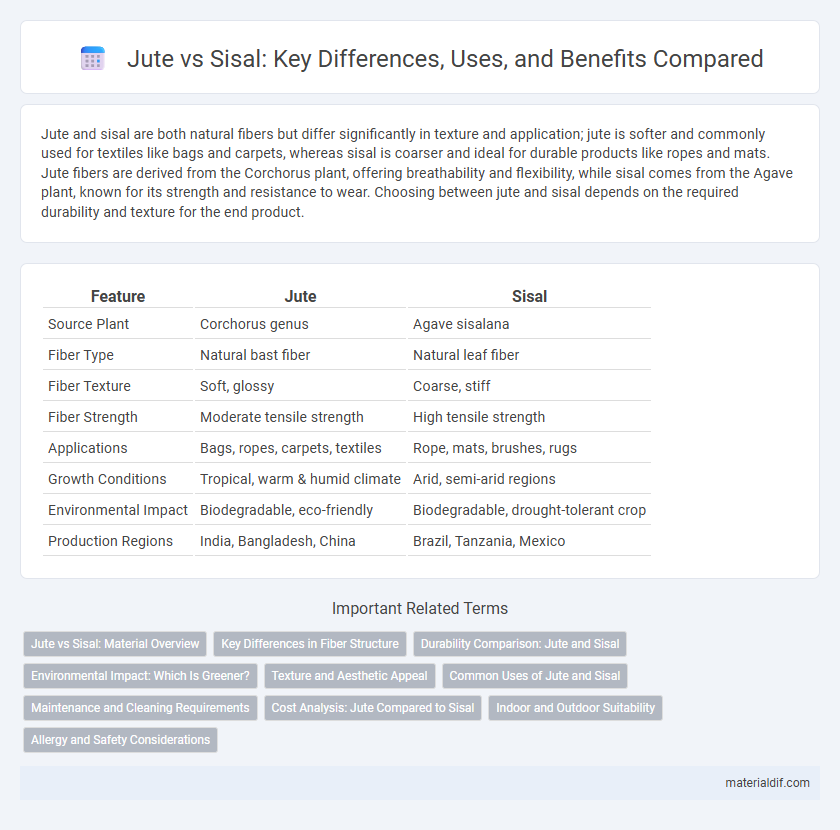Jute and sisal are both natural fibers but differ significantly in texture and application; jute is softer and commonly used for textiles like bags and carpets, whereas sisal is coarser and ideal for durable products like ropes and mats. Jute fibers are derived from the Corchorus plant, offering breathability and flexibility, while sisal comes from the Agave plant, known for its strength and resistance to wear. Choosing between jute and sisal depends on the required durability and texture for the end product.
Table of Comparison
| Feature | Jute | Sisal |
|---|---|---|
| Source Plant | Corchorus genus | Agave sisalana |
| Fiber Type | Natural bast fiber | Natural leaf fiber |
| Fiber Texture | Soft, glossy | Coarse, stiff |
| Fiber Strength | Moderate tensile strength | High tensile strength |
| Applications | Bags, ropes, carpets, textiles | Rope, mats, brushes, rugs |
| Growth Conditions | Tropical, warm & humid climate | Arid, semi-arid regions |
| Environmental Impact | Biodegradable, eco-friendly | Biodegradable, drought-tolerant crop |
| Production Regions | India, Bangladesh, China | Brazil, Tanzania, Mexico |
Jute vs Sisal: Material Overview
Jute is a natural fiber derived from the Corchorus plant, characterized by its soft texture and golden shine, making it ideal for textiles and packaging. Sisal, sourced from the Agave sisalana plant, offers coarser fibers with high durability, widely used in rope, mats, and brushes. Both fibers are biodegradable and eco-friendly, but jute ranks higher in flexibility, while sisal excels in tensile strength and resistance to moisture.
Key Differences in Fiber Structure
Jute fibers are composed primarily of cellulose and lignin, making them softer, more flexible, and better suited for textile applications. Sisal fibers contain a higher lignin content and have a coarser, stiffer structure with long, sharp-edged fibers ideal for rope and matting. The distinct fiber morphology and chemical composition of jute versus sisal determine their respective strength, texture, and end-use suitability.
Durability Comparison: Jute and Sisal
Jute fibers exhibit moderate durability, making them ideal for lightweight textiles and packaging, while sisal fibers offer higher strength and abrasion resistance, suitable for heavy-duty applications such as rugs and ropes. Sisal's natural stiffness and resilience contribute to its superior longevity in outdoor environments compared to jute's susceptibility to moisture and microbial degradation. Selecting between jute and sisal depends on the desired durability, with sisal favored for extended wear and jute preferred for biodegradable, eco-friendly products.
Environmental Impact: Which Is Greener?
Jute cultivation requires less water and fewer pesticides compared to sisal, making it a more environmentally sustainable fiber option. Its natural biodegradability and efficient carbon sequestration during growth contribute to a lower ecological footprint. Sisal, while durable, involves more intensive water use and chemical processing, which can increase environmental strain.
Texture and Aesthetic Appeal
Jute fibers are softer and smoother, offering a more pliable texture that lends itself well to fine textiles and delicate home decor items. Sisal has a coarser, stiffer texture, providing durability but a rougher feel ideal for rugs and mats requiring heavy wear resistance. Aesthetically, jute displays a natural, matte sheen with warm beige tones, while sisal often features a more golden hue with a slightly fibrous, rustic appearance.
Common Uses of Jute and Sisal
Jute is primarily used for making burlap sacks, twine, ropes, and eco-friendly shopping bags due to its softness and biodegradability. Sisal, known for its durability and resistance to moisture, is commonly utilized in mats, carpets, brushes, and ropes for heavy-duty applications. Both fibers serve as sustainable alternatives in the textile industry, but their distinct physical properties dictate their specific uses in packaging, home decor, and agricultural products.
Maintenance and Cleaning Requirements
Jute fibers demand gentle maintenance, requiring dry cleaning or spot cleaning with mild detergents to prevent fiber weakening and color fading. Sisal, being more durable and moisture-resistant, allows for more frequent vacuuming and spot cleaning with water-based solutions, though prolonged exposure to water should be avoided to prevent fiber damage. Proper upkeep of jute and sisal rugs significantly extends their lifespan and maintains their natural texture.
Cost Analysis: Jute Compared to Sisal
Jute offers a more cost-effective option compared to sisal, primarily due to lower raw material and processing expenses. The cultivation of jute requires less water and fewer agrochemicals, reducing overall production costs and making it more sustainable economically. Sisal's higher durability comes with increased costs in harvesting and processing, positioning jute as the preferred choice for budget-conscious industries.
Indoor and Outdoor Suitability
Jute is best suited for indoor use due to its soft texture and lower resistance to moisture, making it less durable in outdoor conditions compared to sisal. Sisal fibers possess superior strength and moisture resistance, ideal for outdoor environments and high-traffic areas. Indoor jute rugs offer natural warmth and comfort, while sisal's robustness supports long-lasting outdoor applications.
Allergy and Safety Considerations
Jute fibers are generally hypoallergenic and safer for sensitive skin compared to sisal, which can cause irritation due to its coarser texture and natural silica content. Sisal's rough fibers may trigger allergic reactions or respiratory issues in individuals prone to allergies, making jute a preferable choice for eco-friendly textiles in homes. Safety considerations also favor jute as it produces less dust and particulate matter during handling or processing.
Jute vs Sisal Infographic

 materialdif.com
materialdif.com